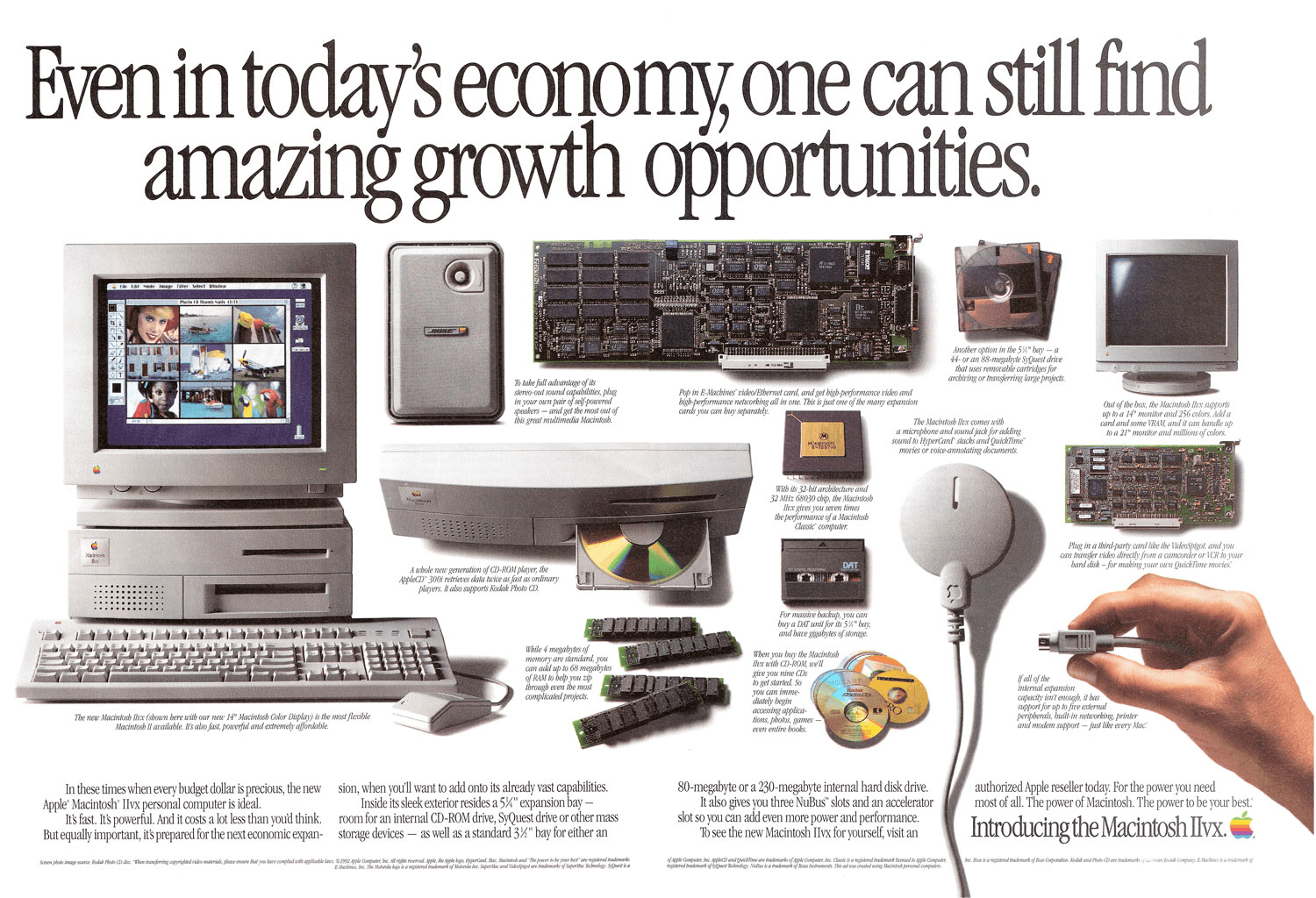 October 19, 1992: Apple launches the Mac IIvx, the first Macintosh computer to ship with a metal case and, more importantly, an internal CD-ROM drive.
October 19, 1992: Apple launches the Mac IIvx, the first Macintosh computer to ship with a metal case and, more importantly, an internal CD-ROM drive.
The last of the Macintosh II series, the Mac IIvx experiences one of the more notorious price adjustments in Apple history. Within five months of shipping, Apple slashes the computer’s launch price of $2,949 to $1,899. That’s one way to reward early adopters!
The Mac IIvx launch
Code-named “Brazil,” the IIvx reportedly started out as a research project to see how an internal CD-ROM drive (compact disc read-only memory) could be incorporated into a Mac. However, after Apple’s then-CEO John Sculley delivered a speech at Macworld Tokyo describing a future Macintosh with this functionality, Apple rushed the computer into production.
At the time — at least from the perspective of a younger user — the Mac IIvx seemed like an impressive machine. Particularly so if you primarily wanted a computer that could play games and utilize the other cutting-edge multimedia software of the era.
The CD-ROM drive launched in 1985, a year after the original Mac shipped. From 1988, Apple produced SCSI-based external CD-ROM drives for the Mac under the name AppleCD. To the vast majority of users, however, these seemed like lavish peripherals. They were not the kind of thing most people attached to a home, office or school computer.
The rise of CD-ROM and QuickTime
The Mac IIvx marked the beginning of Macs shipping with a built-in CD drive. That practice continued until Apple started to phase out the devices with the MacBook Air launch in January 2008. (Apple finally eliminated the CD drive from iMacs in 2012.)
The IIvx also came right around the time that QuickTime started arriving on Macs. The ability to easily play video was, again, incredibly futuristic for its day. The computer came bundled with QuickTime 1.5, a faster, more robust version of the video-decompression software. This let users watch 640-by-480 videos at 30 frames per second.
On top of this, the IIvx could support a second monitor. This let Mac users significantly enlarge their desktop work area by moving documents, files and folders across both screens.
And all this was back in 1992!
So why isn’t the Mac IIvx more well-loved?
With all of that stated, the Mac IIvx should occupy a beloved spot in Apple history. So why do so many people ignore it? And, worse, why did it become one of the only Apple products in history to become a verb? (Many disgruntled users talked about being “IIvx-ed.”)
There are a couple of reasons. The first is that it was significantly underpowered. The IIvx ran a 32MHz CPU on a 16MHz bus, which meant slower performance than the Mac IIci released three years earlier in 1989. The IIci ran 30% faster than the IIvx. And extending the Mac IIci by adding 32KB cache made it a full 60% faster.
The Mac IIvx’s serial port also was limited to 57.6 kbit/s, which caused problems with serial connections and MIDI hardware.
In terms of other specs, the IIvx boasted 4MB of RAM, an 80MB hard drive, three NuBus slots, an accelerator slot and 512K of video RAM (VRAM).
Given the ongoing popularity of the aging Mac IIci, many customers opted for the older, often-discounted computer instead of buying a new model that ran more slowly.
A bigger problem was the arrival of the significantly more powerful Macintosh Centris 650, which turned up four months after the IIvx shipped — but somehow cost $250 less, with a starting price of $2,700.
Apple repositioned the Mac IIvx as the entry-level Centris model (despite not bearing the Centris name). The company also cut the computer’s price to $1,899. People who rushed out to buy the IIvx at launch got bilked out of more than $1,000 in just a few months. The controversial early iPhone price reduction had nothing on this!
One more thing …
Looking back from today’s vantage point, the Macintosh IIvx fills me with a real sense of nostalgia. It also effectively sums up Apple’s pros and glaring cons at the time.
On the plus side, the Mac IIvx was an impressive machine. It almost comically ran rings around the beige plastic boxes running MS-DOS that many PC owners used at the time. The IIvx ran Apple’s System 7 operating system, and helped bring CD-ROM technology into people’s homes.
At the same time, its confusing name once again highlighted how impenetrable Apple’s product line had become less than a decade after shipping the original Macintosh. The fact that Apple speeded the Mac IIvx to market, then made it redundant within months (upsetting loyalists who rushed out to buy it), also speaks to the company’s chaotic culture in the early ’90s.
Do you remember the Mac IIvx? Leave your comments below.



